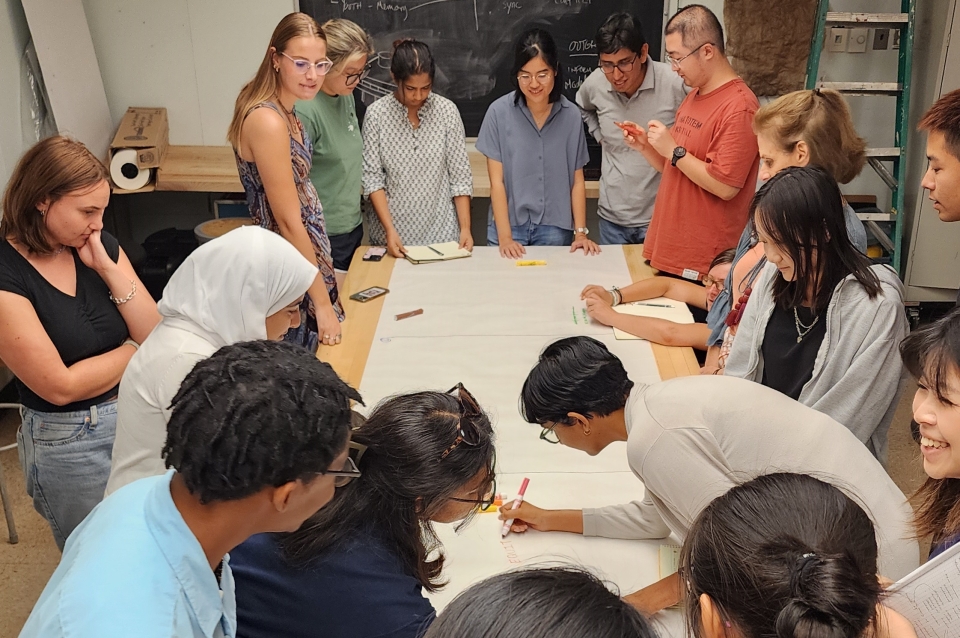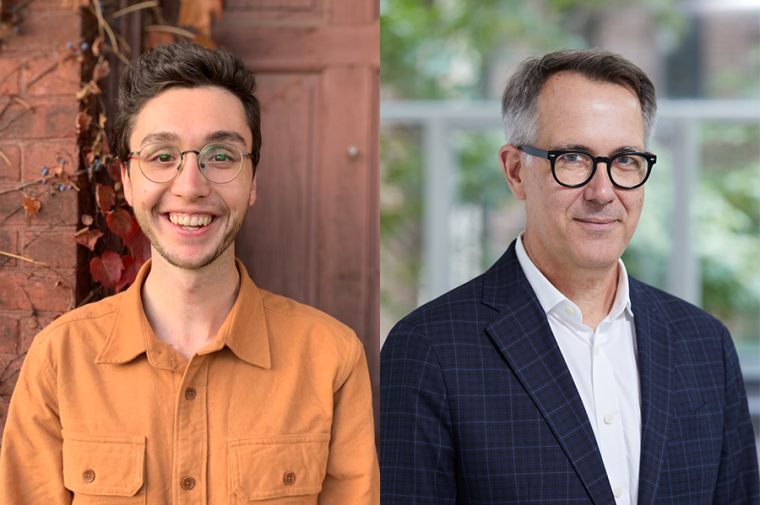October 16, 2024
Stuart Weitzman School of Design
102 Meyerson Hall
210 South 34th Street
Philadelphia, PA 19104
Get the latest Weitzman news in your Inbox
Areas
The Preservation Studio is a keystone of the Historic Preservation curriculum, taken in the fall of the second year. The key learning objective of the Preservation Studio is sound decision-making practices in the face of contemporary preservation challenges.
This semester, student groups are tackling sites across the region ranging from a single building to 3,000 acres. The three sites each intersect with women’s history in unique ways. In this Q&A, the three instructors, Julie Donofrio, Ashley Hahn, and Molly Lester, walk us through the Studio methodology and their site selections.
The studio is a foundational part of the curriculum in design and architecture schools. But what exactly does it mean in the context of Preservation?
Ashley Hahn: The core of the Preservation Studio is this values-centered planning method. It’s a best practice in the field, and that's something that we want everyone to have come away from Studio having worked with. In the world of preservation, we have historically been the most comfortable dealing with physical fabric. That is our technical expertise, and it's a traditional strength of the field. But over the last generation plus, it has become more standard practice to realize that we care about a lot more than just the physical fabric. We care about why something matters to people. And that can be in the realm of personal connection, like how we use and live with historic places all the time.
For example, I care about my neighborhood park not necessarily because it's historic, though it is, but because that's where we do a beautiful concert series every June, and it's where my neighborhood comes together, and it really is meaningful to me, and that's been going on for a long time. It's that sort of quality that you don't necessarily see when you visit a place, you can't touch it. So we want to try to understand what those attributes might be, and consider how those values can be balanced, elevated, which ones might be the most important ones to safeguard and promote, and other ones that we want to make sure are considered as a site continues on its course.
Why studio?
AH: Because all preservation professionals have to plan at some point. We're all part of teams. We're all part of project teams that have diverse skills and interests and clients. And so this is an important practice opportunity for the students to take what they've learned in the first year and apply it.
Can you define the “plan” in preservation planning? Is it related to the planning discipline?
Julie Donofrio: It's a plan for the future. It's not necessarily the planning discipline versus preservation. A site needs a plan for the future, and whether or not that's conservation, or a cultural landscape, we help them think that through.
AH: That’s right, it is a future oriented stance. So it's about considering why a place matters, to put it simply, and then from that understanding, making a set of recommendations toward some specific objectives.
Can you share a bit about the sites?
Molly Lester: My site is currently the Delaware Children's Theatre, but it was built as the New Century Club of Wilmington in 1892. It was designed by Minerva Parker Nichols, who was the first woman in the country to practice architecture independently, for a women's club that formed in the late 19th century to give women a place to organize around self-education and civic reform. And so this building hosted public programming, educational classes, lectures, meetings, fundraisers.
It existed in that way until the 1970s, when the club shut down. The building was briefly a dinner theater, but it was increasingly at risk until a woman named Marie Swajeski stepped in and bought the building to be the Delaware Children's Theatre. Her daughter, Donna Swajeski, runs that theater today as its artistic director. So every inch of the building is put back into use as this theater, and that is a fantastic case of adaptive reuse, but it also presents some really interesting challenges today in terms of how to continue to manage this building with a history that they're proud of, but isn't primary to their mission.
JD: I am working with students on the Whitesbog Preserve, which is a historic cranberry and blueberry farm located within the Pine Barrens in southern New Jersey. I think it is a is an interesting site for exploration because it has so many different layers. There are a lot of values associated with the Pine Barrens themselves, the history of labor, the history of child labor, all sorts of social, agricultural trends of the early 20th century. There's also a lot of questions in terms of climate and the ongoing viability of them as a business. It's 3000 acres, so from a scale perspective, our sites are wildly different.
I think this is a great preservation question because out in professional life, it's so rare that we just have our singular perspective, as a preservationist or a planner. We're always interacting with other professions and people with different perspectives when we are creating whatever the plan is. And I think that this site does interact so much with planning and landscape, ecology, climate science, public history, there's just so many woven intricacies that really drew me to the site. And we don't know what the values are going to be that come out of this, why this place matters. I know what I think, but that could all change after talking to the board, or after talking to the public, and we've yet to figure that out.
AH: So for my site, I'm working on the Village of Arts and Humanities, which is at N 10th and Germantown Avenue in Philadelphia. And it's about a four-and-a-half-acre campus of properties that are not all contiguous, dotted across several blocks. Its origins are in the Black Arts Movement, where, as an outgrowth of the Civil Rights and Black Power movements, there were performing artists, visual artists, and writers working to reclaim art forms for and by Black people.
A choreographer and dancer named Arthur Hall who essentially squatted in the building on Germantown Avenue, rehabbed it, and turned it into the Ile Ife Black Humanitarian Center, a dance and music community that became very well-known and Hall’s company performed all over the world and at some very notable Civil Rights events. In the mid 80s, Arthur Hall invited a Chinese artist named Lily Yeh to work on bringing art outside the building, creating a landscape in an area that had seen very dramatic and systemic racist disinvestment and the decline of a lot of properties. Lily Yeh began working to put up, first, a mural on the outside of the building, and then turning the lots next door into an art park. And she did this with the neighbors, using simple materials for non-experts, like cement on chicken wire to make sculptures, which they mosaicked. And so there were many hands that ended up creating this art landscape. They made murals, organically shaped furniture, seating areas, sculptures and curvy walls and some of the sculptures are animals and trees and people.
Today the Village of Arts and Humanities, which is the successor organization to the Ile Ife Black Humanitarian Center, operates as a community space. Youth participate in tons of after school programs and summer programs in the arts, primarily, but also they have an urban farm, and adults also are invited to participate in different programs there. It's all arts oriented, and it's a place of real joy and beauty and power. They've done a lot of incredible work to reinvest in the programs and in these buildings.
The next phase now, which is where we come in, is around understanding the art landscape and how to tell its story really well. So there's a little bit of understanding the condition that's in, but also how to interpret it and how to tell the story of the people who made it and why it's there. There are memorials that are part of this landscape, there are allegories and symbols. All of this essentially goes under interpreted on site. That organization is very busy running its own programs. But it's this really interesting legacy of people making something from the neighborhood for themselves, by themselves, and that legacy continuing.
So our hope is to do a very future-oriented preservation strategy for this art landscape, and how to tell its story as the neighborhood is changing, as the village itself is kind of in the generational shift.
What makes a good studio project?
AH: I think it's important to have very different scales represented and different disciplines foregrounded. So it's even though there are thematic connections between these very different kinds of sites, having a little something for everyone is the hope.
It's also a priority for me to be in Philadelphia. It’s a priority for us to stay in the region, not only because that's simpler, but because I believe in doing work at home. That is a civic responsibility of this department, period, full stop.


 Expand Image
Expand Image

